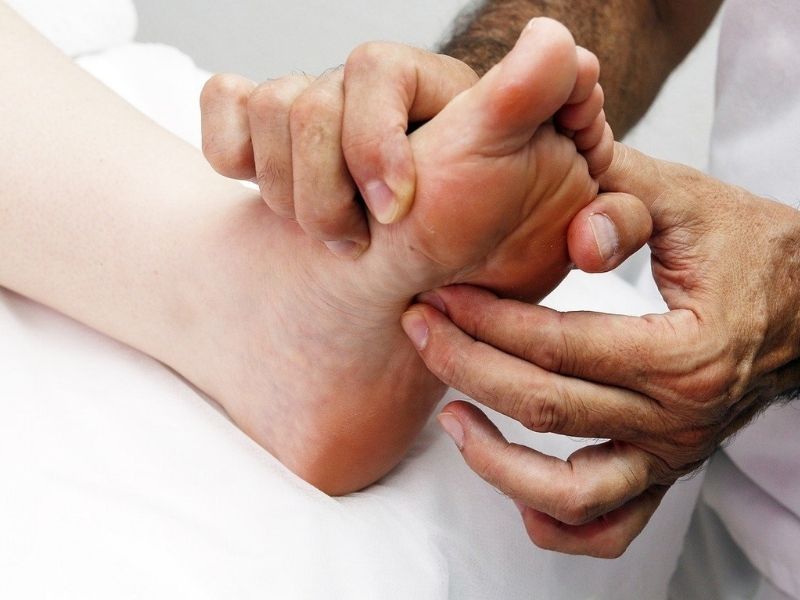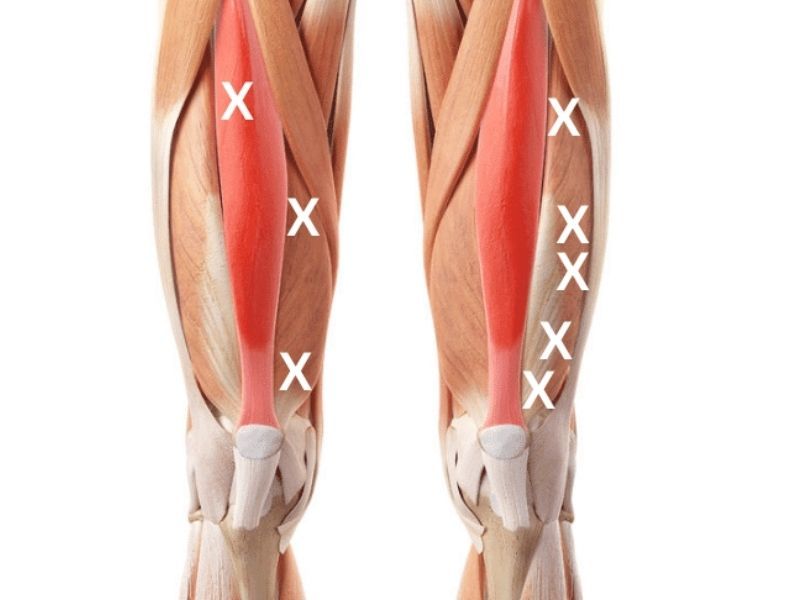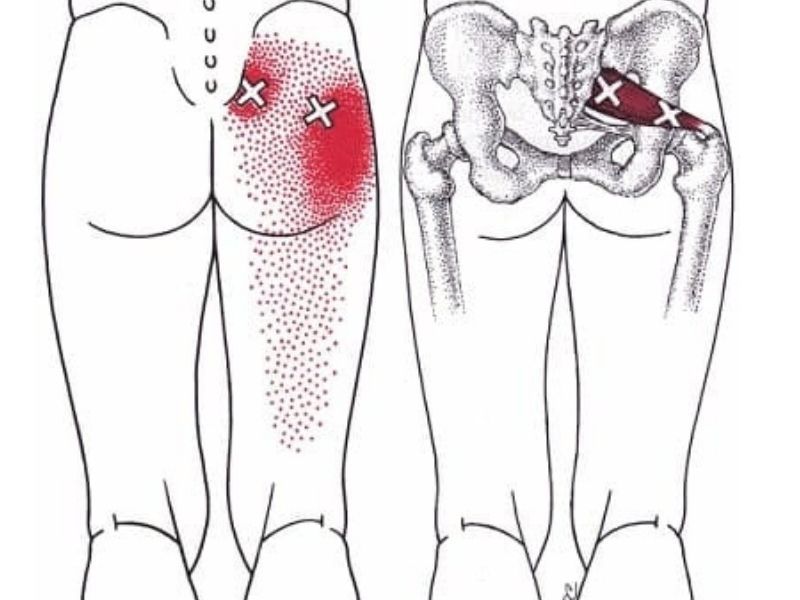Trigger Points For Plantar Fasciitis | How To Find And Release

Table of Contents
- - Locating Plantar Fascia Trigger Points
- - The Science Behind Trigger Points
- - Foot Trigger Points
- - Calf Trigger Points
- - Peroneal Trigger Points
- - Tibialis Trigger Points
- - Trigger Point Release Techniques
- - Static Pressure Release
- - Kneading
- - Muscle Energy Techniques
- - Does self release with a trigger point roller help?
- - Important Tip: Follow up with stretching
- - Alternative Treatments for Plantar Fasciitis
- - A Comprehensive Treatment Plan for Plantar Fasciitis
Myofascial trigger points are a controversial topic, especially when it comes to chronic pain. Keep this in mind when setting expectations for learning about trigger points for plantar fasciitis.
Trigger point therapy can be helpful if muscular dysfunction is a contributing factor in your individual case. In some situations it is possible that trigger points can mimic plantar fasciitis type pain, and upon resolving them, the problem may go away completely.
There is rarely a single pressure point to relieve plantar fasciitis pain, but instead, a collection of them that can be found in the surrounding muscles of the foot and ankle.
In this article, I’ll show you the most relevant trigger points, but keep in mind this is NOT an exhaustive list. There are other trigger points found further up the leg that have the potential to refer sensations down to the foot, and therefore may also contribute to this trigger point pain phenomenon.
So, with that said, let’s get started on finding these little pressure points.
Locating Plantar Fascia Trigger Points
The Science Behind Trigger Points
Trigger points are often referred to as “knots” in your muscles that form when fibers are unable to relax. While the actual concept of a muscle knot is highly debatable, these sensitive points can contribute to pain and limit your range of motion. In the case of plantar fasciitis, trigger points often form in the calf and foot muscles, which can exacerbate the pain in your foot. Treating these trigger points can provide improved muscle performance and facilitate the rehabilitation process.
Foot Trigger Points
Plantar fasciitis occurs when the plantar fascia, a thick band of tissue running from your heel to your toes, becomes inflamed. This band acts like a shock absorber for your foot, and when it’s strained, you feel pain, especially while walking or standing. Understanding the anatomy of your foot can help you grasp why trigger points are so crucial in treating plantar fasciitis.
There are a lot of small muscles in the foot, commonly referred to collectively as the “instrinsic” foot muscles. Many of these muscles can harbor trigger points that can be sensitive right where they are located, OR, can refer sensations to the most common pain point near the heel.
It is possible that in some cases an individual’s entire problem is not actually the plantar fascia, but instead the problem being generated by these local trigger points.
These muscles are generally easily accessible, but one common issue in self-treating them is hand fatigue. I do recommend using a appropriate tool (which I’ll cover down below) in order to effectively work these key trigger points.

Calf Trigger Points
Trigger points located in the calf muscles can create either local dysfunction or refer sensation down to the foot. There is a pressure point in the medial calf that can refer directly into the commonly painful spot on the heel, so it is worth investigating.
There are 2 calf muscles: the gastrocnemius and the soleus. The gastrocnemius rests on top of the soleus, so this muscle will need to be addressed first. As tension and sensitivity is reduced, you will have a better chance at influencing the deeper soleus muscle.
While you won’t be able press straight down through the gastroc muscle, you will be able to access the soleus at the inside and outside parts, near the shin bone.

Trigger points are challenging for therapists to find (and agree on!), so for most people, you aren’t likely to “feel” anything specific under your finger, but you will be able to notice an area that seems very sensitive, and even more importantly refer sensations down the leg.
In my opinion, the areas that refer sensations are most important to address. Since these tender points are challenging to locate to begin with, you might consider using a simple skin marker to make a dot or “X” so that you can easily locate the spot again with ease. This can also be helpful when showing a professional massage therapist where your trigger points are.
Peroneal Trigger Points
The peroneal muscles are found on the outside part of the shin. Even though there are not any common trigger points that refer to the bottom of the foot, this muscle has an important role in function.
Its main job is plantar flex (think calf raise) and evert the foot, so effectively stabilizing the outside part of the foot + ankle.
Trigger points are fairly common in this muscle and alleviation can often make the foot feel as if it’s “moving better”.

Tibialis Trigger Points
The tibialis, both anterior and posterior parts, could be strong contributors to plantar fasciitis. The tibialis functions as a sort of “stirrup” for the foot, and therefore is involved in pronation.
When you consider that over-pronation may be one of the factors that leads to excess stress on the plantar fascia to begin with, it would sense to address this muscle.
Trigger points in the anterior muscle refer directly to the big toe, while pressure points in the posterior muscle can refer directly to the achilles tendon. (Also interesting to note the common relationship between achilles issues and plantar fasciitis!).
Anterior tibialis trigger points are easy reach, but the posterior is far more difficult because of its deep location under the larger calf muscles. While it is somewhat possible to access a portion of it coming in from the side of the shin, it’s best to work with a professional therapist to get better access to this one.

Trigger Point Release Techniques
Trigger point massage for plantar fasciitis muscle work can involve a number of different techniques. Any of them can be effective, but all of them may not work for everyone. Some experimentation may be needed.
Static Pressure Release
Static pressure is the classic method for trigger point therapy. Once the tender pressure point is located, pressure with a thumb or tool is added and held until the sensitive spot reduces in intensity.
There isn’t a lot of agreement by therapists in how hard to press, but generally if we use a 1-10 scale, a 5, which is midway, would be a good place to start when self-massaging.
Kneading
Kneading can involve a number of different movements, but generally the idea is to grab, pinch, roll or stretch the tissues in varying directions, which often increases blood flow to the area and helps de-sensitize the trigger point.
Muscle Energy Techniques
Muscle energy techniques (MET) involves a series of osteopathic-based techniques aimed at triggering the nervous system to relax muscles that have increased muscle tension.
The two primary techniques are called:
Post Isometric Relaxation (PIR) – This technique involves a very low intensity contraction of the muscle that contains the trigger point, with a controlled inhale + exhalation, then subsequent relaxation of the contraction. This process is repeated 3-5 times until full relaxation is achieved.
Sample Technique:
Reciprocal Inhibition (RI) – This techniques involves a contraction of the OPPOSITE muscle that contains the trigger point. In doing so, there is a degree of reduced activity in the target muscle, which can reduce the sensitivity of trigger points.
This technique also involves a breathing component, and the intensity of the muscle contraction may vary depending on individual ability.
I’m a big fan of these techniques, because they are easy to perform, relatively gentle, and can rapidly reduce trigger point activity in the host muscle. Covering these techniques would require an entire blog post to itself, but I wanted to mention them here due to their immense value.
Sample Technique:
Does self release with a trigger point roller help?
While not a technique itself, I wanted to address the most common version of self massage, which is rolling on a foam roller. The roller can help you with static release and a simple version of repeated compression of tissues.
While simple and can generally hit some easy to reach trigger points, it’s not very efficient for dealing with more specific trigger points. This is because the broad contact surface of the roller will often miss the precise trigger points mentioned in the areas above.
Massage tools attempt to help fix this problem, and they can be useful as well, but only after examining the tissues with your hands and locating the trigger points that need to be treated.
Important Tip: Follow up with stretching
Locating and releasing trigger points for plantar fasciitis needs to be a multi-step process. This means you can’t just massage them away.
It’s important to re-train your muscles (+ nerves) on how to change their behavior. An easy way to do this involves stretching the muscles right after treating the trigger points. Kinesiology taping for plantar fasciitis is also helpful in reducing trigger point sensitivity.
As trigger point sensitivity is reduced, there is a sort of window-of-opportunity to teach the nerves how to keep the changes. It doesn’t take much. 2-3 repetitions of a stretch, held for 30 seconds can effectively get the job done.
Lastly, be sure to note exercises for plantar fasciitis to avoid.
Alternative Treatments for Plantar Fasciitis
While trigger point therapy can be very helpful in some cases, it’s not the only treatment out there. Here are some alternative treatments you might consider that are often utilized:
- Acupuncture: This ancient Chinese technique involves inserting needles into specific points on your body, including your foot, to relieve pain.
- Physical Therapy: Exercises can strengthen your foot and calf muscles, improving your condition over time.
- Orthotic Inserts: Custom-made shoe inserts can provide the extra support your foot needs.
A Comprehensive Treatment Plan for Plantar Fasciitis
When it comes to dealing with issues like plantar fasciitis, it is VERY important to utilize a multi-disciplinary approach to achieve the best results. Its crucial to rule out any potential underlying serious pathology, and also identify and address any contributing factors that exist in one’s lifestyle.
- Consult a Specialist: Always start by consulting a healthcare provider for an accurate diagnosis.
- Trigger Point and/or Myofascial Release Therapy: Schedule regular sessions with a certified therapist.
- Home Exercises: Perform stretching and strengthening exercises as advised by your therapist.
- Lifestyle Changes: Consider weight loss and proper footwear to reduce strain on your plantar fascia.
- Follow-up: Regularly consult with your healthcare provider to track your progress and make necessary adjustments to your treatment plan.
[wp-stealth-ads rows=”1″ mobile-rows=”1″ tags=”plantar fasciitis sa”]
Article Image Note: I have pulled images from online for utilization in this post, and while I’m not sure exactly where they are from, I do believe they are from Travell and Simon’s Myofascial Trigger Point manuals. If you know, I’m happy to properly attribute these images.
Article Research:
Trigger Point Therapy and Plantar Heel Pain: A Case Report
Sam Visnic
I’ve spent my life studying the fundamental aspects of human health with a focus on movement and clinical massage therapy. In a world of specialists, surgical procedures, drugs and quick fix remedies, I’m committed to finding and developing strategies that help people stuck at the “gap”. Over the last 20 years I’ve studied dozens of systems and methodologies for uncovering the root cause of aches and pains, along with postural and movement issues. Pain science, the art and science of hands-on soft tissue massage techniques, myofascial release, and coaching movement is essential in my practice. Integrating different methods but above all deciphering WHEN to use different techniques with different people and situations, along with integration of movements that people want to be able to do again is the key to long term success with my incredible track record with clients. Understanding the various elements that contribute to conditions and the power of communication and education makes my Release Muscle Therapy program separate from other hands-on therapy approaches.
Blogs You May Be Interested In
Categories
-
Deep Gluteal Pain Syndrome
-
Deltoids
-
Fallbrook
-
Foam Rolling
-
Glutes
-
Hamstrings
-
Hypnosis For Pain
-
Lats
-
Levator Scapulae
-
Lifestyle
-
Massage Therapy
-
Mobility
-
Movement and Exercise
-
Murrieta
-
Muscles
-
Nutrition
-
Obliques
-
Pain
-
Pectorals
-
Piriformis
-
Plantar Fasciitis
-
Product Review
-
Psoas
-
Quadratus Lumborum
-
Quadriceps
-
Rhomboids
-
Serratus Anterior
-
SI Joint
-
Sternocleidomastoid
-
Stretching
-
Subscapularis
-
Temecula
-
TMJ
-
Trapezius
-
Uncategorized
















